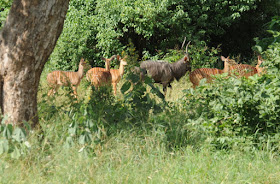Here, in a side arm of the Zambezi, swims a Hyppo,
closely followed by its offspring.
Observe: The Hyppo's ears, eyes and nose are on one level, therefore, although almost totally submerged,
the animal has all its senses available.
It can hear, see and smell any approaching danger,
recognize friend or foe,
without exposing itself to obvious view.
"Ain't Nature wonderful ?"
The Waterbuck, this happens to be a group of females,
has a white circle on its hindquarters.
Why did nature decide on such an obvious marking ?
A definite sign, visible by a predator, long after the rest of the animal has disappeared from view into the bush.
The American White Tail Deer, throws up its tail, when in flight, thereby exposing the white underside clearly.
Biologists have surmised that thereby a young deer does not lose sight of its parent and is able to follow it more easily.
Is it reasonable to assume that the white circle on the Waterbuck's behind fulfills the same purpose ?
What is Nature up to ?
A proud male Waterbuck, showing the same markings.
The Ground Hornbill, when not in flight,
sports a completely black-feathered body. (above)
When in flight, it shows its brilliantly whited wing tips. (below)
It is generally assumed that nothing in Nature is without purpose.
What was Nature up to ?
The Nyala is the only Antelope
in which the male shows a fundamentally different color than the female.
The horned male is a medium grey, while the females show a light brown.






No comments:
Post a Comment